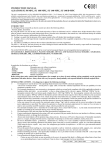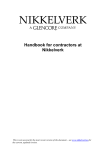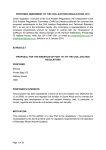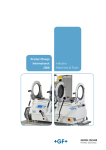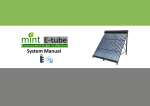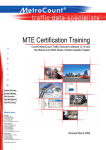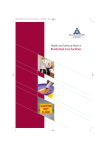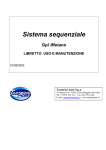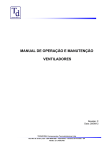Download Effer Safety Manual - Versalift East, LLC
Transcript
GB Operational Safety When Using Cranes 1 GB Premises T T he contents in this manual are to be considered additional specifications to the rules already set forth in the Crane User Manual. hose of you reading this manual must also read and comply with the contents in the manual you receive when picking up the crane. Crane Use and Maintenance Manual + Operational safety when using cranes ☞ Sol.Ge. S.P.A. All rights reserved No part of this may be published without prior written permission. 2nd edition - September 2001 - code 1935126/GB 2 Introduction Dear Crane Operator, ♦ We would like to thank you for spending some of your time on a topic of which those of you who have worked with cranes for many years are well aware of. However, we wish to ensure that both you and your fellow workmates work in complete safety and would therefore like to go over a number of aspects that we consider of utmost importance. ♦ Newspapers and television programmes report a number of accidents involving people who have carried out the same activities on a daily basis for many years at home, most of which are caused by bad judgment. It is therefore easy to imagine that such accidents - unfortunately - also happen when operating a crane. ♦ The aim of this leaflet is to improve operational security and thereby reduce the number of accidents caused through not applying safety standards or distraction. We do not intend to teach those of you who have operated cranes for many years how to work. We merely wish to remind you that most of the information regarding accidents show that they are almost all caused by distraction, underestimating danger or - more banally - a desire to finish a job too quickly. ♦ A number of the topics we have covered are part of the most known rules regarding lifting of loads and have been personalized for hydraulic crane operators. ♦ Those of you who read this leaflet - which aims to provide additional information and suggestions to ensure you work under the best possible safety conditions - must obviously know and comply with all Laws on the use of lifting equipment in the workplace. 3 GB GB Introduction Before we begin with the technical contents in this leaflet, we want to emphasize that an employer and a responsible operator are the first indispensable elements in order to ensure that the working environment and working conditions are safe. Basic Concepts In order to prevent accidents in the workplace some Basic concepts must be held present: we take the opportunity to list some hereunder, with the idea that, if observed, they will contribute to improve safety and health of workers when using the crane. - IT SHALL BE THE RESPONSIBILITY OF EACH WORKER TO TAKE CARE AS FAR AS POSSIBLE OF HIS OWN SAFETY AND HEALTH AND THAT OF OTHER PERSONS AFFECTED BY HIS ACTS OR COMMISSIONS AT WORK IN ACCORDANCE WITH HIS TRAINING AND THE INSTRUCTIONS GIVEN BY HIS EMPLOYER. TO THIS END, WORKERS MUST IN PARTICULAR, IN ACCORDANCE WITH THEIR TRAINING AND THE INSTRUCTIONS GIVEN BY THEIR EMPLOYER: ➬ ➬ ➬ ➬ ➬ ➬ make correct use of machinery, apparatus, tools, dangerous substances, transport equipment and other means of production; make correct use of the personal protective equipment supplied to them and, after use, return it to its proper place; refrain from disconnecting, changing or removing arbitrarily safety devices fitted, e.g. to machinery, apparatus, tools, plant and buildings, and use such safety devices correctly; immediately inform the employer and/or the workers with specific responsibility for the safety and health of workers of any work situation they have reasonable grounds for considering represents a serious and immediate danger to safety and health and of any shortcomings in the protection arrangements; cooperate, in accordance with national practice, with the employer and/or workers with specific responsibility for the safety and health of workers, for as long as may be necessary to enable any tasks or requirements imposed by the competent authority to protect the safety and health of workers at work to be carried out; cooperate, in accordance with national practice, with the employer and/or workers with specific responsibility for the safety and health of workers, for as long as may be necessary to enable the employer to ensure that the working environment and working conditions are safe and pose no risk to safety and health within their field of activity. 4 GB Attitude to work - Knowing your crane In compliance with that set forth, the employer shall: - take appropriate measures so that workers and/ or their representatives in the undertaking and/or establishment are fully aware of all health and safety laws; - take appropriate measures so that workers and/ or their representatives in the undertaking and/or establishment comply with all health and safety laws; - provide all the necessary information to ensure that the health and safety of workers is protected; Provide that no person under the age of 18 may operate a crane, thereby ensuring that operators are responsible adults. Operators must be fully fit to carry out this kind of work, in other words they must not: √ have any sight defects, √ have any hearing defects, √ suffer dizziness at operating height, √ be addicted to drugs or alcohol, √ be unable to effect ordinary movements. The psychological well-being of a crane operator is also extremely important, therefore all operators must: √ be responsible persons, √ not experience stress in the workplace, √ neither operators nor workmates may take medicines before or during a shift unless under medical supervision. 5 18 GB Attitude to work - Know-how Now that we have discussed the crane operator ...what about his workmates? They most certainly should have the same characteristics above stated, though we would like to add that they are also required to comply with any indications the crane operator provides without taking any personal initiatives. The workmates of crane operators often have the terrible habit of standing underneath a load that is being moved or to use their hands to accompany the load: ...what if the load falls for some reason who is responsible??? Should a load require aligning, a pulley can be fitted - which only takes a few seconds. THIS IS WHAT IS MEANT BY OPERATING SAFELY!!! _ A crane operator must know his crane: more specifically, he must know how to install a crane on its truck and be well aware of the dangers deriving from improper use. _ The most well-known rules regarding load lifting dedicate entire chapters to training for crane operators before they begin to use such equipment. This training initially involves operating a crane - even for just half a day - after having carefully read the relative manual and having moved loads in the presence of an experienced crane operator, where possible. 6 Recommended equipment We shall now deal with operative aspects, splitted in individual chapters: _ We are all aware of current Laws on accident prevention, which set forth the appropriate clothing to wear in the workplace - e.g. hard hats, gloves, etc. _ It is extremely important for the crane operator to apply command levers precisely and gradually, which is why he must wear comfortable clothing. _ Crane operators must not operate in temperatures so low as to cause slow reflexes and their hands must not be hampered by hard or worn gloves. 7 GB GB Operative area Can anyone walk through an area in which a crane is operating??? _ Everyone knows the answer to this question: NO-ONE MAY WALK THROUGH AN AREA IN WHICH A CRANE IS OPERATING. _ Very few operators carry the red and white tape that can be used to cordon off a public access area or an area on a site through which other workers may pass and in which a crane is operating. _ How many times has a worker been shouted at for not noticing that a crane is in operation and passing under the load? _ We would like to remind you that the operator is responsible for cordoning off a work area or using any other means available to ensure no workers pass through or stand around an area in which a crane is operating. _ Before commencing work, operators must ask the safety officer on a site or industrial area of the dangers in areas in which a crane is to maneuver or those that can be caused when using a crane. 8 Suitability of the ground on which a crane operates How many accidents in the workplace are caused through the ground on which stabilizers are placed sagging??? Statistics prove that there are MANY. _ It is difficult to foresee sagging, especially if stabilizers are placed on apparently solid ground. _ It is worth remembering that land can sag for a number of different reasons. _ We recommend using wood shims or bearing slabs to place under the stabilizers to avoid any futile accidents. _ Never think that you have compacted any land that sags for just a few centimetres and therefore continue working. Stop work immediately and place a large and sturdy surface between the stabilizer and the ground. _ Take great care to detect the location of underground sewers - the stabilizer of a mediumsized crane creates enough pressure on the ground to make it sag. 9 GB GB Stabilizing the truck • The truck must be in level, stabilizers completely extended and laying on the ground, the chassis slightly raised and the wheels balancing on the ground to ensure proper stabilization. • At times, this may not be possible due to sloping or to the fact that there is too little space for the lateral stabilizers to come out. We would like to remind you that cranes may rotate automatically when operating on small slopes and thereby become extremely dangerous. • We would also like to remind you that if the stabilizers do not come out laterally, the truck will not be fully stable. For this purpose, you must pay great attention to oscillations from the operating truck to avoid it turning over. YOU CAN WORK IN SAFETY DESPITE THE ABOVEMENTIONED DIFFICULTIES BY ADOPTING A FEW SIMPLE PRECAUTIONS. • Place a wood shim under any truck wheel that lifts by a few centimetres to ensure that the brake still works. Apply a scotch under wheels - these are rarely used, despite the fact that operator manuals always recommend their use. 10 ? Stabilizing the truck _ Constantly check the position of the stabilizers opposite to the crane arm when stabilizers are not fully extended (thereby making the truck unstable). _ Loads may be moved even if a stabilizer lifts a few centimetres from the ground. _ Avoid making rapid downward movements and, above all, making brusque stops as these may cause the truck to jump. _ Rotating maneuvers must be effected at minimum speed while continuously checking stability of the truck. 11 GB GB Load diagram _ Ensure that there is a diagram of the crane load to consult and thereby establish whether the crane is able to handle the load involved for the established distance. 0 1 2 75? 6 7 8m 9m 8 7 6 5 4 3 daN 1 0 -1 -2 -3 ? kg How can this be avoided??? _ See if the first boom is strong enough to lift the load as the load moves away from the slewing axis. WHEN A LOAD STOPS RISING, THE CRANE HAS OBVIOUSLY REACHED ITS LIMIT. 12 2 (kg) m _ The load in cranes without overload safety device must be moved away from the cranes rotation axis until it reaches the point in which the excess pressure valves automatically open, thereby lowering the load to the ground. (Please note that these devices were made obligatory through the Directive on machinery implemented in Italy in 1996.) This may, of course, cause damage and even cause the truck to turn over, should the reach increase too much. 4 5 WHAT IF YOU DO NOT KNOW HOW MUCH THE LOAD WEIGHS? _ The overload safety device (when fitted) will prevent overloading and block a number of the cranes maneuvers. For this purpose, the operator cannot operate the crane until bringing the load towards the rotation axis. 3 ? Operating practice _ Practice will certainly help operators become more familiar with cranes and thereby ensure they work in complete safety. _ Practice - both with and without loads - is the only way for operators to learn how to effect various movements simultaneously. Special training is recommended to help cut down load oscillation as far as possible. Cranes are affected by load oscillation - leading to up to 30% overload and understandable consequences to the structure, which may also affect the stability of the truck. A good operator is able to carry out crane movements by scaling maneuvers on departure and arrival. 13 GB GB Move the load away from the signalman Operational needs over the last 10 years have led to the construction of increasingly longer cranes, which make it more and more difficult to talk to the other people working with the crane. _Many accidents occur simply because the operator did not understand what maneuver to make. This can easily be avoided by implementing a series of signals, which must be followed as a system of communications to ensure safety in the workplace. WHEN IN DOUBT, DO NOT OPERATE A CRANE! lift the crane boom lower the crane boom move the load towards the signalman move the load away from the signalman lift the load with the winch lower the load with the winch rotate the crane to the left rotate the crane to the right extensions out extensions in by hand, can the load emergency stop be moved or not RECOMMENDED SIGNALS 14 Slings and chains used to lift loads GB We feel that a chapter on lifting accessories that are applied to the crane hook to lift loads is necessary as a large number of accidents are caused by non-compliance with the most basic regulations. We would like to remind you that the operator is responsible for accidents caused through the use of inappropriate lifting accessories. Brache di fibre Fibre sling _ Slings may be useful in a number of operations to ensure a load is not damaged or to tie it more securely. Fibre slings shall be permanently marked with the following information: √ Manufacturers name √ Materials used √ Maximum load √ Trademark (only for European countries) _ The following recommendations are made by sling manufacturers regarding their correct use: √ √ √ √ Check the full length of the sling before each lift. Do no use slings that appear damaged. Do not use slings without labels. Avoid using slings with slots shorter than 3.5 times the diameter of the pivot or hook on which they operate. √ Never place an element that may cause damage in a slot. The mechanism to which the slot is hooked must be: - smooth, without any cutting edges - the correct shape and size to ensure that it does not break any stitching nor overload the sling. !! 15 GB Slings and chains used to lift loads √ Never use damaged slings. √ Always protect the parts of slings that come into contact with cutting or sharp edges. √ Never shorten a sling using knots - this may cause the breaking load to decrease by up to 50%. √ Never lift with slings that are folded in stitching or holding areas. √ Avoid crushing slings with the load by placing shims between the load and the support. √ Never run over slings with trolleys or vehicles. √ Keep slings clean and dry. Dirty slings should be washed with water and hung to dry. Dirt, sand and dust cause tiny fractures to occur in the fibre and thereby lead to rapid deterioration and a reduction of up to 50% in the breaking load. √ Any slings that come into contact with chemical agents may corrode and must therefore be put out of use. √ Never place slings on a hot surface and keep them away from sources of intense heat and cutting or welding operations causing sparks. Violent rubbing may also cause high temperatures - excessive temperatures are one of the worst causes of deterioration as the effects are not necessarily visible to the eye. √ Slings must not be used following 5 years from the date of manufacture shown on the label. 16 Slings and chains used to lift loads GB Metal slings • Metal slings include steel cables with extremities that can be attached to the crane hooks and the loads to be lifted. Sling cables are usually made in polished steel and are flexible with 6 strands. Metal slings shall be permanently marked with the following information: √ Manufacturer's name √ Maximum load √ Trademark (only for European countries) • The following recommendations are made by sling manufacturers regarding their correct use: √ Never use slings for loads above the rated load. √ Never use slings of doubtful origin. √ When using slings with more than one arm, take into account the variation in rated load as the top angle varies. √ √ √ √ Never use slings with over 120° difference to the upper apex. Always check the sling before lifting. Never use damaged slings. Always protect any cable touching live edges (live edges are any edges with a curve range less than or the same as the cable). √ Never bend slings near couplings or cable terminals. √ Avoid bending steel cables over small pivots or hooks. The rated load of a cable decreases rapidly and the cable becomes difficult to control when bent on a diameter less than 6 times its own diameter. For example, bending cable on a pivot twice the diameter of the cable may lead to a 50% reduction in its original rated load. ? 17 GB Slings and chains used to lift loads √ Avoid crushing slings with the load by placing shims between the load and the support. √ Never remove slings from under a load if that is what the load is resting on. √ Keep slings in a dry warehouse - preferably spread over a rack - and oil regularly to avoid corrosion. √ Never use solvents to clean slings - brush and oil only. √ Never leave slings lying on the ground where they can be run over by wheels or crawler tracks. Regular overhaulings and checks _ Steel cable slings must be regularly checked depending on the work for which they are used and always at least once every three months. Both the cables and terminals must be carefully checked and the following noted: - cables: broken wires, corrosion, plastic deformation, wear and tear, distortion of the strand wires, burns (traces of overheating), crushing, bottling, eyes, cuts and stretching. Particular attention must be paid to the point of attachment in the area the cable leaves the couplings and terminals. You are also recommended to bend cables to look for signs of any broken wires - couplings: any deformation, crushing, wear and tear, incisions or onset of unthreading. - hooks: deformation, stretching, widening at the entrance opening, incisions, breaks or unsafe entrance. - terminals: deformation, crushing, stretching or loose pins. - rings and suspension arms: deformation, cuts and stretching. - thimbles: deformations making them unable to protect cables. 18 Slings and chains used to lift loads GB _ Steel cable slings must be removed and destroyed when the following occurs: √ √ √ √ √ √ diameter decreases by 10% or more _ Steel cable slings must be removed and destroyed when the following occurs: one or more strands are broken dents or permanent bends signs of corrosion when one or more strands are loose or stick out of the cable, even when in tension when the cable fibres change colour, thereby demonstrating that they have been subjected to overheating, electric arcs or welding sparks. √ deformation, wear and tear, cuts with consequent reduction in diameter of 5% or more, even if in just one area √ hints of the onset of cable unthreading √ onset of breaks at the slot due to incorrect use (inserted in too large a hook or pin). Brache di catene 19 GB Slings and chains used to lift loads Chain slings _ Chain slings group chains with terminal endings that can be attached to the crane hooks and loads to be lifted. Chain slings shall be permanently marked with the following information: √ Manufacturers name √ Maximum load √ Trademark (only for European countries) _ The nominal size of the chain (chain size) is the diameter of the chain mesh steel rod measured outside the welded area. The following recommendations are made by chain manufacturers regarding their correct use: Never paint or zinc-plate chains. Never use slings of doubtful origin. Never use slings for loads over the rated load. Always check the sling before lifting. Never use damaged slings. Never use slings with over 120° difference to the apex. Never use bolts to attach chains. Always protect any cable touching live edges. Never remove slings from under a load if that is what the load is resting on. Never leave slings lying on the ground where they can be run over by wheels or crawler tracks. dsfr g dsfr cvfd gcv fd √ √ √ √ √ √ √ √ √ √ 20 GB Slings and chains used to lift loads √ Avoid crushing slings with the load by placing shims between the load and the support. √ Regularly clean and oil slings to prevent rusting. √ Clean and oil slings and keep in a dry place. Regular overhaulings and checks _ Chain slings must be regularly checked depending on the work for which they are used and always at least once every three months. _ Both the chains and components must be carefully checked to ensure they are suitable, i.e. they are not affected by the following: - chains: must be cleaned before each check and each link closely examined to note the following: √ √ √ √ √ wear and tear, bends and deformation cuts reduction in the section stretching ? OIL 21 GB Applying loads to the hook at the far-end of a sling _ The hook entrance opening may be widened through overloading or incorrect positioning of the load. 16% ~ 20% ~ _ We shall now provide four typical examples of decreased load capacity in eye hooks: load capacity is reduced by 60% when the load weighs solely on the spout. 30% ~ 22 50 ÷ 60% ~ Variation in the rated load of a sling in accordance with the top angle GB _ The rated load gradually decreases as the angle at the apex increases (the angle created under the hook) in two-arm slings. The rated load for slings at a given top angle is obtained by dividing the maximum vertical load capacity by the coefficient for increasing diagram tension. It is not recommendable to use slings with top angles exceeding 120°. The same table can be used for doubts regarding the size of the top angle after calculating the ratio between the sling length (L) and the distance between attachments (A). 23 GB Practicing movements with loads Keep a safe distance when operating stabilizers. Do not operate stabilizers when loaded. At work start - especially in the cold - make a few practice moves to allow the oil to become appropriately fluid and ensure that the equipment is working correctly. Immediately stop commands at the end of a run to avoid oil overheating. Avoid brusque stops when the crane is loaded as this will damage and cause useless stress to the crane, especially when descending. 24 GB Practicing movements with loads Check that lifted loads do not exceed what set forth in the table with regards to distance. Loads must conform to this table, above all when a load is to be lifted from nearby the crane and moved as far away as possible. Never fully rely on the load limiting device valve. The lifting potential of a crane is directly in proportion to the distance between the longitudinal axis on the 1st arms cylinder and the joint between the column and the 1st boom. For this purpose, you must discover the rated load by positioning the 1st boom to face slightly upwards from the horizontal axis when you wish to lift the loads stated in the table. Cranes are only stable when the stabilizers are fully extended - avoid blocking their exit. Do not drag loads along the ground, but rotate with loads lifted from the ground. Avoid jerky movements while maneuvering as these cause more stress to the structure than the load itself. 25 90° +2° ÷ 4° GB Practicing movements with loads Never move the vehicle with a hanging load. The entire structure of the crane is designed and built to carry the loads shown in the table and with the arms positioned between the horizontal and maximum vertical axes. For this purpose, you must never apply loads to arms with a different configuration (e.g. negative arms). You must also never apply downward pressure with crane arms. Never work near electricity lines: cranes are not insulated. You must therefore take into account oscillations of the load and the structures elasticity Incorrectly positioned cables may open: the safety hook block must always be able to return to its initial position when cables are in place. 26 GB Daily checks _ The operator is responsible for declaring a crane in working condition. What does this mean?? What is the operator expected to do?? JUST A FEW ADDITIONAL THINGS TO THOSE LISTED ABOVE TO ENSURE YOU WORK IN COMPLETE SAFETY. √ Check that the oil in the tank is at the maximum level while the crane is folded. √ Check that the load diagram stickers are attached and legible. √ Check that the controlbank levers have all the necessary knobs and labels to indicate the crane movements. √ Check that there is a hook safety lock and that it moves freely. √ Check that there are safety split pins at the pins terminals to block the hook and any relative equipment. √ Check that there are no evident signs of oil leaking from the cylinders, pipes or hydraulic fittings. 27 OIL 0 1 2 75? 3 4 5 6 7 8m 9m 8 7 6 5 4 3 daN 2 (kg) m 1 0 -1 -2 -3 GB Crane maintenance. Filter greasing/cleaning Is it important to grease the crane??? YES. _ Moving components undergo less wear and tear and the crane gives a better performance when lifting loads if properly oiled. Applying excessive oil too infrequently is useless: cranes should be greased frequently (e.g. every 4050 working hours) by injecting oil until it begins to overflow from the pivot lodgings. This operation should also be repeated with the crane in different configurations to ensure the oil is distributed evenly. The structural steel parts below the extensions should be greased more frequently (e.g. every 30 hours). These require just a thin layer of grease to ensure that the extension sliding pads rollers last longer. Refer to the crane user manual for grease characteristics. And clean oil filters??? OIL YES. GREASE _ Oil filters are as important to a crane as they are to the truck engine. No-one would dare not replace the oil filters in the truck - it is easy to imagine the consequences! Unfortunately, it is common belief that crane oil filters and hydraulic oil do not need replacing!!!!! 28 GB Crane maintenance. Filter greasing/cleaning _ The hydraulic components of a crane need maintenance. Impurities that deposit in the oil filter may circulate and damage the components - thereby causing the vehicle to stop and leading to repairs that are more costly than a mere replacement filter - if not removed. $ _ Oil tanks also have an air filter. The oil level in the tank drops when the cylinders are opened and air enters the tank. If this air contains, for example, particles of dust and the air filter does not hold them, they come into contact with the oil. _ According to the manufacturers of oil for hydraulic pressure systems such as those used in cranes oil loses its properties after one year. Oil in cranes that are used rarely can be changed less regularly. However, if you do not replace oil, you risk having to replace components in the hydraulic system. THIS IS ENTIRELY UP TO YOU! _ The oils and greases that may be used for the above maintenance are described in the User/ Maintenance Manual. 29 G e nn Febb M a rz OIL aio A g o sto S e tt e mbre A p r il e M a gg G iu g L u g li o ra io o io no O tt o bre N ov e m b r e D i c e mbre ! GB Crane maintenance. Visual check on the structure _ The structural size of cranes has been designed in accordance with engineering calculations that comply with a number of safety coefficients set forth by the Law. _ The structural part of a crane is therefore subject to wear and tear - or more simply old-age. The more a crane is used, the earlier this becomes obvious - although the way a crane is used also has an influence. Any crane used at top performance every day will require extraordinary maintenance earlier than a crane used irregularly and for light work. It is therefore extremely important to visually check the structure - once every six months at first, increasing the older a crane gets up to every two weeks after 5 or 6 years of operation. _ The following system is recommended: √ Wash the entire structure carefully √ Wait for the crane to dry in the open air (for at least one day) √ Check the weldings throughout the structure √ Check that the structure around weldings is intact. 30 Crane maintenance. Visual checks on the structure _ Cracks in the painting near weldings (rust coloured) indicates that there is an onset of breaking and repairs must be made immediately!!! 31 GB GB Crane maintenance. Loss of oil from pipe fittings _ Small oil leaks or simple sweating from hydraulic pipe fittings or pipe endings may occur. The immediate thing to do is tighten the joints and, if the problem persists, tighten even further. What if a pipe fitting breaks while doing this??? _ If the pipe-fitting of a pressurized circuit breaks (around 30% of hydraulic pipes are pressurized even when the truck power takeoff is disconnected), an extremely dangerous jet of oil will come out and cause serious injury to the operator - forcing him to go immediately to hospital! _ The following list of precautions must be taken when dealing with an oil leak, in other words when tightening hydraulic pipe fittings: √ The power takeoff must be disconnected and the hydraulic oil be at environmental temperature √ The crane must be folded behind the cabin or with its extremity resting on the ground √ Use normal keys, without any extensions √ Never tighten too far (dynamometric keys are recommended) √ Never hit the key with a hammer √ Keep your body as far away as possible _ Contact an authorized workshop should the results be unsatisfactory. You are strongly recommended not to take pipe fittings or pipes out to replace with similar parts, since using materials with different properties to those required may cause problems, or even worse, accidents. 32 ? Crane. Identifying defects _ An operator is satisfied when: √ His crane moves quickly and perfectly √ His crane is able to lift the loads he requires. CAREFUL MAINTENANCE IS THEREFORE ESSENTIAL TO ENSURING THAT THE OPERATOR IS SATISFIED! Do not forget that a number of parts are subject to normal wear and tear, e.g. gaskets inside a cylinder, hydraulic valves, the hydraulic pump or even hose. _ The earlier a crane is brought to an authorized workshop at the onset of a problem, the less repairs will cost. _ The arm of a crane will involuntarily drop if the gasket inside a cylinder is worn. A valve may not work properly and require replacing if a piece of rubber comes away from a gasket. _ Noisy hydraulic pumps or discontinuous movements by a crane mean that the piston inside the pump is damaged. Parts of the piston may go into circulation and damage components in the hydraulic system (including the chrome on the rods) if the crane continues to operate. _ When the outside coating on rubber pipes is damaged following an accident or through age, the metal mesh will be corroded through contact with air and rain and the pipe will explode, thereby putting the crane out of order. 33 GB GB _ Safety rules The rules and general principles outlined previously may be summarized as follows: 1- THINK BEFORE YOU ACT. 2- REMEMBER THAT NO WORK MUST BE EFFECTED MECHANICALLY, BUT MUST BE THE RESULT OF THINKING: APPLY THE PROCEDURES YOU LEARNED IN TRAINING CAREFULLY AND PRECISELY. 3- REMEMBER THAT TIDY WORK IS SAFE WORK. 4- TRY TO IDENTIFY THE ELEMENT OF DANGER IN EACH ACTION YOU MUST TAKE AND IMMEDIATELY INFORM FELLOW WORKERS OF ANY DANGERS NOT PREVIOUSLY TAKEN INTO CONSIDERATION. 5- TRY TO AVOID RISKY OPERATIONS. 6- REMEMBER THAT TIME SPENT ENSURING SAFE CONDITIONS IS NEVER WASTED TIME. 7- REMEMBER THAT OTHERS ARE WORKING WITH YOU AND MAY BE AFFECTED BY ANY ACCIDENTS YOU CAUSE. 8- NEVER FORGET THAT FINISHING WORK QUICKLY WHILE IGNORING SAFETY IS NOT AN IMPROVEMENT. 9- ALWAYS CONSULT YOUR DIRECT SUPERIOR IF YOU HAVE ANY DOUBTS REGARDING A JOB. 10- REMEMBER THAT PHYSICAL WELL-BEING IS THE REAL ASSET OF ANY WORKER. 34 Conclusion Dear Crane Operator, EFFER would like to thank you for taking your time to read this leaflet. We are sure you were well aware of all the information contained herein and, as we said at the start, we certainly do not expect to teach you how to use a crane safely. The aim of this leaflet is to inform you of the possible causes of accidents that unfortunately occur with expert crane operators. However, we are sure that if you keep this leaflet in the cabin of the truck and read through it from time to time, you will work under safer conditions. We hope you enjoy working with the EFFER crane. 35 GB GB NOTES:___________________________________________________ __________________________________________________________ __________________________________________________________ __________________________________________________________ __________________________________________________________ __________________________________________________________ __________________________________________________________ __________________________________________________________ __________________________________________________________ __________________________________________________________ __________________________________________________________ __________________________________________________________ __________________________________________________________ __________________________________________________________ __________________________________________________________ __________________________________________________________ __________________________________________________________ __________________________________________________________ __________________________________________________________ 36 GB Sol.Ge S.p.A. Via Bonazzi 12/14 - 40013 Castel Maggiore (Bologna) Italy +39 051 4181211 - Fax.: +39 051 701492 www.effer.it e-mail: [email protected] Leaflet distributed by: EFFER dealer: Company using EFFER cranes: Stamp The leaflet entitled Operational Safety when Using Cranes has been given to: Mr. ..................................................................................................... Company name ................................................................................. Position ............................................................................................. Date .................................................................................................. ✑✒ ✄ Signature .......................................................................................... 37 GB 38 GB 39 GB Sol.Ge. S.p.A. Via Bonazzi 12/14 40013 Castel Maggiore (BO)-Italy +39 051 4181211 Fax.: +39 051 701492 www.effer.it e-mail: [email protected]










































